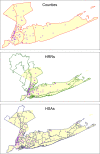Use of hospitals in the New York City Metropolitan Region, by race: how separate? How equal in resources and quality?
- PMID: 35948923
- PMCID: PMC9365444
- DOI: 10.1186/s12913-022-08414-3
Use of hospitals in the New York City Metropolitan Region, by race: how separate? How equal in resources and quality?
Abstract
Background: Although racial and ethnic minorities disproportionately use some hospitals, hospital-based racial and ethnic composition relative to geographic region and its association with quality indicators has not been systematically analyzed.
Methods: We used four race and ethnicity categories: non-Hispanic white (NHW), non-Hispanic black (NHB), Hispanic, and Asian/Pacific Islander/Alaskan Native/American Indian (API/AIAN), as well as a combined non-NHW category, from the 2010 (latest year publicly available) Medicare Institutional Provider & Beneficiary Summary public use file for 84 hospitals in the New York City region. We assessed the relative distribution of race and ethnicity across hospitals grouped at different geographic levels (region, county, hospital referral region [HRR], or hospital service areas [HSA]) using the dissimilarity index. Hospital characteristics included quality star ratings, essential professional services and diagnostic/treatment equipment, bed size, total expenses, and patients with dual Medicare and Medicaid enrollment. We assessed Spearman's rank correlation between hospital-based racial and ethnic composition and quality/structural measures.
Results: Dissimilarity Index decreases from region (range 30.3-40.1%) to county (range 13.7-23.5%), HRR (range 10.5-27.5%), and HSA (range 12.0-16.9%) levels. Hospitals with larger non-NHW patients tended to have lower hospital ratings and higher proportions of dually-enrolled patients. They were also more likely to be safety net hospitals and non-federal governmental hospitals.
Conclusions: In the NYC metropolitan region, there is considerable hospital-based racial and ethnic segregation of Medicare patients among non-NHW populations, extending previous research limited to NHB. Availability of data on racial and ethnic composition of hospitals should be made publicly available for researchers and consumers.
Keywords: Disparities; Dissimilarity index; Health systems; Medicare; Race and ethnicity; Segregation.
© 2022. The Author(s).
Conflict of interest statement
The authors have no relevant financial or non-financial interests to disclose.
Figures


Similar articles
-
Racial and ethnic disparities in access to and enrollment in high-quality Medicare Advantage plans.Health Serv Res. 2023 Apr;58(2):303-313. doi: 10.1111/1475-6773.13977. Epub 2022 Apr 9. Health Serv Res. 2023. PMID: 35342936 Free PMC article.
-
Variation in racial/ethnic disparities in COVID-19 mortality by age in the United States: A cross-sectional study.PLoS Med. 2020 Oct 20;17(10):e1003402. doi: 10.1371/journal.pmed.1003402. eCollection 2020 Oct. PLoS Med. 2020. PMID: 33079941 Free PMC article.
-
Reducing geographic, racial, and ethnic disparities in childhood immunization rates by using reminder/recall interventions in urban primary care practices.Pediatrics. 2002 Nov;110(5):e58. doi: 10.1542/peds.110.5.e58. Pediatrics. 2002. PMID: 12415064
-
Racial and Ethnic Disparities in Primary Open-Angle Glaucoma Clinical Trials: A Systematic Review and Meta-analysis.JAMA Netw Open. 2021 May 3;4(5):e218348. doi: 10.1001/jamanetworkopen.2021.8348. JAMA Netw Open. 2021. PMID: 34003274 Free PMC article.
-
The politics of racial disparities: desegregating the hospitals in Jackson, Mississippi.Milbank Q. 2005;83(2):247-69. doi: 10.1111/j.1468-0009.2005.00346.x. Milbank Q. 2005. PMID: 15960771 Free PMC article. Review.
Cited by
-
Segregation in hospital care for Medicare beneficiaries by race and ethnicity and dual-eligible status from 2013 to 2021.Health Serv Res. 2025 Apr;60 Suppl 2(Suppl 2):e14434. doi: 10.1111/1475-6773.14434. Epub 2025 Jan 11. Health Serv Res. 2025. PMID: 39797574
-
Poorer Nurse Staffing in Black-Serving Hospitals.Nurs Res. 2025 Jan-Feb 01;74(1):73-78. doi: 10.1097/NNR.0000000000000787. Epub 2024 Oct 11. Nurs Res. 2025. PMID: 39666469
-
Measuring Equity in Readmission as a Distinct Assessment of Hospital Performance.JAMA. 2024 Jan 9;331(2):111-123. doi: 10.1001/jama.2023.24874. JAMA. 2024. PMID: 38193960 Free PMC article.
-
Associations Between Measures of Structural Racism and Receipt of Acute Ischemic Stroke Interventions in the United States.J Am Heart Assoc. 2025 Apr;14(7):e037125. doi: 10.1161/JAHA.124.037125. Epub 2025 Mar 26. J Am Heart Assoc. 2025. PMID: 40135561 Free PMC article.
References
MeSH terms
Grants and funding
LinkOut - more resources
Full Text Sources
Medical

